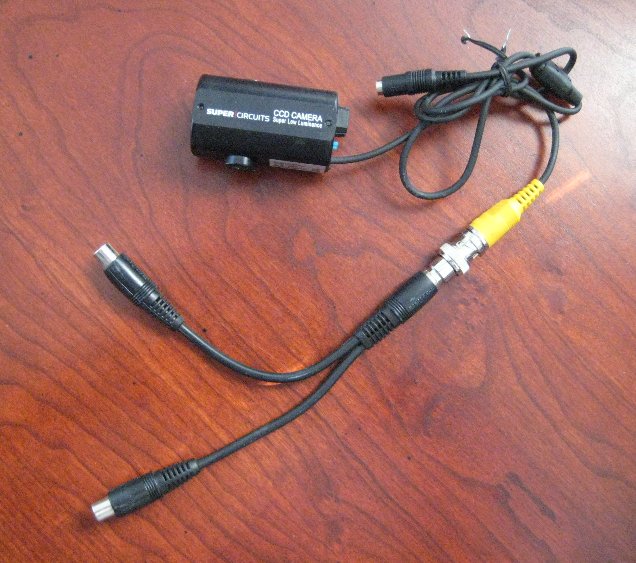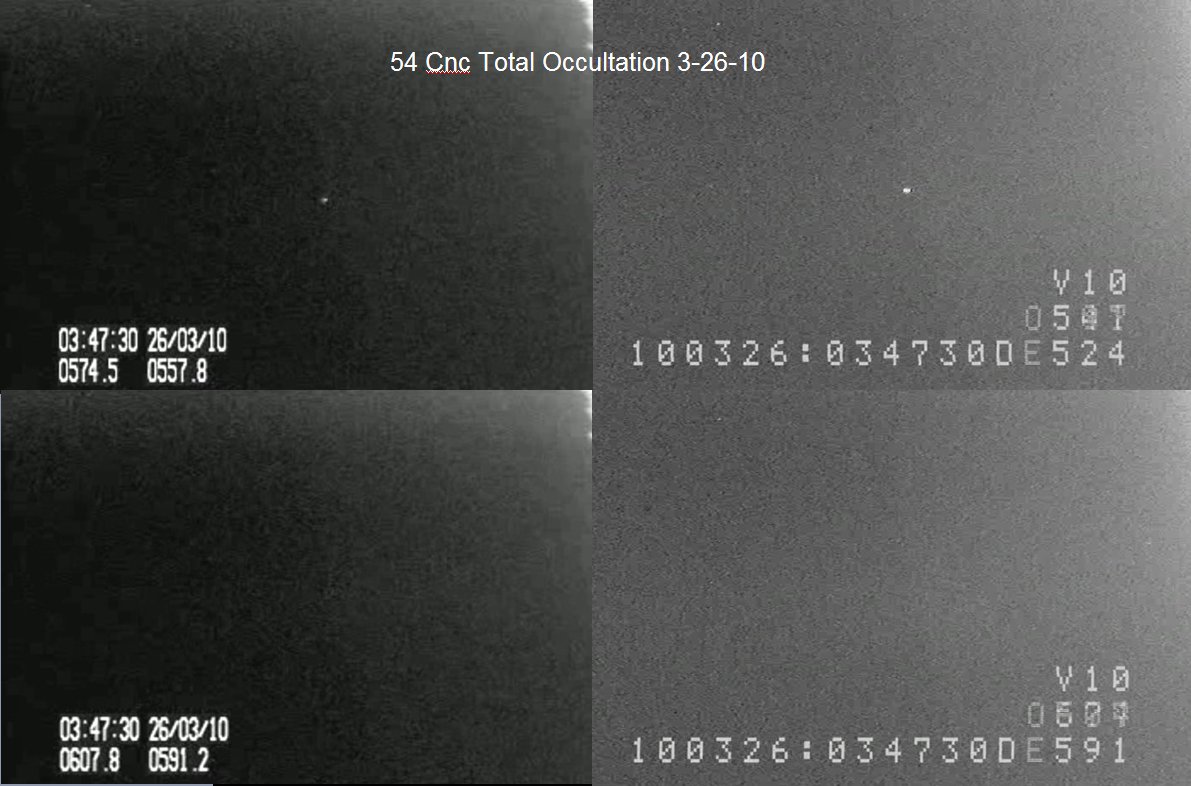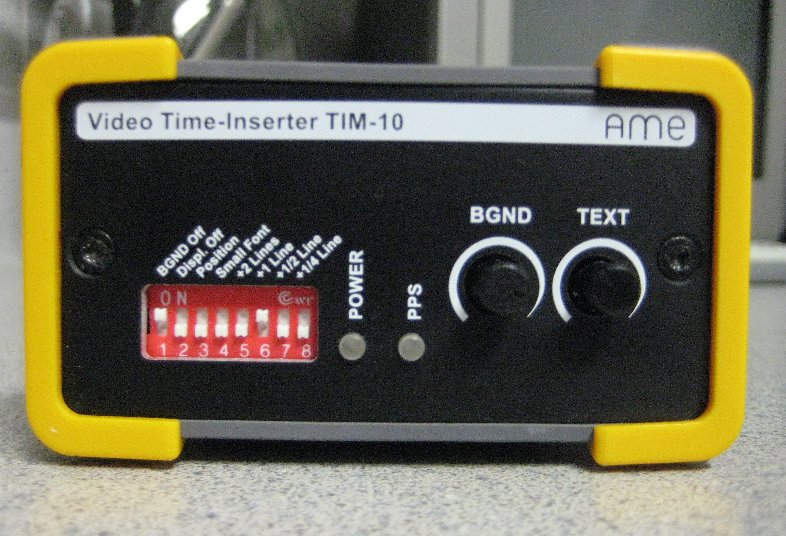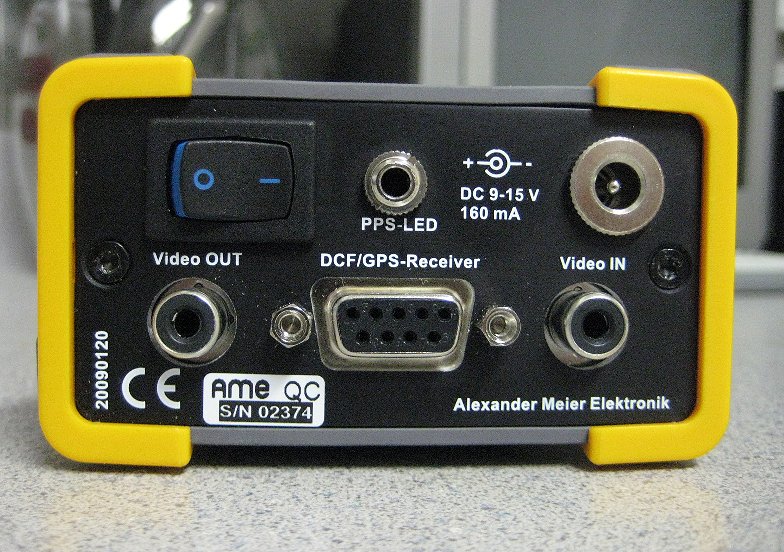
Lunar occultation timing comparison - 2 different model GPS Time Inserters
Two GPS time inserters currently available for occultation timings were used to simultaneously time the occultation by the Moon of 54 Cnc ( m = 6.37) on March 26, 2010. The time inserters used were the Blackbox Camera Co. "Sprite" unit (London) and one made by the Alexander Meier Electronik TIM-10 unit (Germany). These will be referred to the BBC unit and the AME unit.
Both time inserters were driven by a single Supercircuits camera using a Y-type cable attached to a telescope:

The video frames just before and after the occultation are shown below:

The upper frames are the ones just before the occultation, lower frames just after the occultation.
Left Frames: BBC unit
Right Frames: AME unit
The two left side frames (BBC unit) show that the star was visible at 3h 47m 30.557sec, disappeared 3h 47m 30.591sec. These frames were recorded by a 30 frame/sec DVR.
The two right side frames (AME unit) show that the star was visible at 3h 47m 30.524sec, disappeared 3h 47m 30.591sec. These frames were recorded by a 25 frame/sec DVR. This non 30 fps DVR missed recording the frame just before the occultation.
However both time inserters gave the identical time of the occultation, even the times displayed on the fields. The lower right frame's (AME unit) field times are faint and changing but they do match the lower left frame BBC unit.
Quick look at GPS Time Inserters Compared
Blackbox Camera Co. Sprite unit & Alexander Meier Electronik (AME) unit
For IOTA and other applications, a GPS based video time inserter (VTI) utilizing the 1 pulse per second (1 pps) signal is the basis for timings. These timings are overlaid onto the video screen simultaneously with the target object.
In 2009, with the KIWI GPS time inserter unit discontinued, there is still a continuous need for an available precision affordable VTI unit. The two units tested here are the Blackbox Camera Co. Sprite unit (purchased directly from London) and the Alexander Meier Electronix (AME) unit from Germany. The AME unit is advertised directly available from Adirondak Video.
BLACKBOX CAMERA COMPANY SPRITE2 UNIT
The Blackbox Camera Co. Sprite unit is in limited supply and the company is selling off their remaining inventory of units. This author purchased a unit in January 2010 off their website http://www.blackboxcamera.com/pic-osd/sprite.htm The website price is currently 120 British Pounds. The company advertises that they HAVE A LIMITED SUPPLY of these units and once sold out, they're gone.
The unit comes with a magnetic base GPS antenna connecting with a 2-meter coaxial style cable (see above photo). The GPS receiver is built right into the unit. The supplied antenna amplifies the 1 pps signals. The box unit size is 5 3/8" x 5 1/2" x 2", weight 10 oz. It can be powered by 9-12 Volts.
The 4 modes of display in a video are shown in this clip:
Blackbox Camera Company unit modes of displaying information. Display is white text with a black background. Continuous pressing of the red "Select" button on front of unit changes display mode. The date shown is February 18, 2010.
ALEXANDER MEIER ELECTRONIK VIDEO TIME INSERTER TIM-10
This time inserter is made by the Alexander Meier Electronik company in Germany. It is described on their website here: http://ame-webshop.de/product_info.php?cPath=28_3_12&products_id=4 and available from the US distributor Adirondak Video. The unit's size is 3.25"x 4.25" x 2" and weighs 10 oz. Front and back views are shown below:


Left Image: This unit allows adjustments of the screen, i.e., the small white switches 1-8. These customize what you can display, date, time, Latitude/Longitude, size and position of text. The two knobs marked "BGND" and "TEXT" adjust the brightness of the data displayed with background. The "PPS" light flashes at the top of each second.
Right Image: The unit can be powered by 12v DC as the Blackbox unit. Video in/out connections are marked. The GPS receiver needed is the same as used by the KIWI, the 1 pps Garmin 18 LVC.
This video clip demonstrates how the switches and brightness controls work:
The AME unit's display is controlled by switches 1-8 plus the brightness adjustment knob. This unit does not provide elevations.